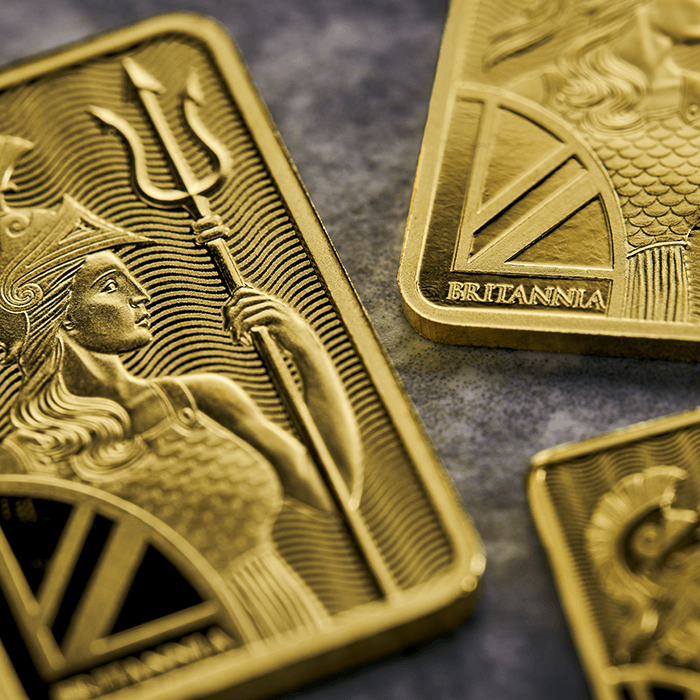Before their conversion to Christianity, Viking Age Scandinavians – including those who settled in Britain – believed in a pantheon of gods and supernatural creatures. Recorded in Snorri Sturluson’s The Prose Edda, composed in the thirteenth century and serving as the world’s extensive source of Norse mythology, the tales of these pagan gods have captured imaginations for centuries.
In tribute to these mighty deities, we have released a minted bullion bar collection comprising gold and silver bars, with the first of three releases honouring Odin, the All-Father and chieftain of the Norse gods.

Ruler of Asgard, God with 12 Names
The gods of Norse mythology live in a realm called Asgard, where Odin reigns as king and is the greatest and most renowned of the Aesir, the family of gods who once warred with a rival faction of gods called the Vanir. Eventually, the Aesir and Vanir sought an everlasting truce and came to live in harmony, fusing together as a single group. Odin is known by many names and in Asgard,
he has 12, including All-Father, Herran or Herjan (Lord), and Fjolnir (Wise One).

Father of the Slain
Odin is often referred to as the Val-Father, which means ‘Father of the Slain’ , as all those who die in battle become his adopted sons and ascend to live in Valhalla, one of Odin’s great halls. Known there as the Einherjar, they spend their days feasting and drinking, nourished by meat from a boar called Saehrimnir who is cooked each day but becomes whole again by the next. However, Odin himself doesn’t eat – wine is enough to keep him replenished – and instead, the Val-Father gives the food from his table to two of his companions, the wolves Geri and Freki.
The goat Heidrun stands on top of Valhalla, eating leaves from a tree called Lerad, and from Heidrun’s udders flows mead that fills a gargantuan vat large enough to quench the Einherjar’s thirst every day. The warriors partake in a daily battle and those who perish are taken back to Valhalla where they become whole again, ready to drink and feast. The Einherjar are Odin’s to command and will fight for the All-Father at Ragnarök, the twilight of the gods, where garbed in a gold helmet and a magnificent coat of mail, he will lead them clutching his mighty spear Gungir.
Knowledge Acquired Through Sacrifice
Often depicted as old and wise, Odin is the god of knowledge yet his wisdom came at a price. The All-Father once travelled beneath Yggdrasil, the world tree, to the Well of Mimir. The well contained wisdom and intelligence, so Odin approached Mimir and asked for one drink from the well. Mimir allowed it but only after Odin sacrificed one of his eyes. He gave his eye and placed it at the bottom of the well, earning mystical insight and knowledge of the future in the process. Odin quested for more esoteric knowledge and hung himself from a tree, sometimes considered to be Yggdrasil, for nine days and nights to gain further understanding of runes.
Odin sits upon a throne called Hlidskjalf in Valaskjalf, one of his many celestial halls. From this seat, the All-Father can see all over the universe. Representing thought and memory respectively, two ravens sit upon his shoulders named Huginn and Muninn, who fly over the world every morning, gathering news and information to bring back to Odin.
The Mead of Poetry
The Aesir and the Vanir sealed their truce by each god spitting into a vat. From the spittle they created a man called Kvasir to serve as a physical mark of the alliance. Knowledgeable in all things, Kvasir could answer any question put to him. He travelled all over the world to bestow his knowledge upon others but during a visit to them, the dwarves Fjalar and Galar murdered Kvasir and mixed his blood with honey, creating the mead of poetry. Just one sip of this mead would enable the drinker to recite lines and stanzas of the most beautiful verse and the mead eventually ended up in the possession of a giant called Suttung, from whom Odin retrieved it and returned it to Asgard.
Using cunning and his shape-shifting abilities, Odin snuck into the mountain where the mead was guarded by Suttung’s daughter Gunnlod. The All-Father used charm to persuade Gunnlod to allow him three drinks from the three vats containing the mead. Odin used each sip to drain the vats, one by one. As Suttung burst in after discovering the theft, Odin transformed into an eagle and soared back to Asgard, spitting the mead back into vats belonging to the Aesir. This is why poetry is known as ‘Odin’s catch, find drink or gift’, as well as ‘the drink of the Aesir’.

Father of Thor and Blood Brother of Loki
Odin is father to Thor, the god of thunder renowned for his strength. Thor wields Mjolnir, his almighty hammer that is feared by all frost and mountain giants. In addition to fighting, Thor has a voracious appetite and loves to feast and drink.
Odin travels between the worlds on his eight-legged horse called Sleipnir, a child of Loki and gift to the All-Father from the ‘Slanderer of Deceit’. Many of Loki’s mischievous and villainous antics cause headaches for the gods of Asgard but he often finds cunning solutions to his self-made problems.
Following the release of our stunning gold and silver minted bars honouring Odin, king of the Aesir, Thor and Loki shall join the collection in early and late 2025 respectively.




